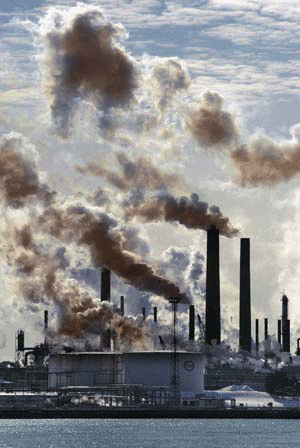Oct. 17-23, 2013, Current Events Lesson Plan
Current Event:
Hazardous air pollution in the northeast Chinese city of Harbin forced the closure of schools, paralyzed traffic, and shut down the airport. The Harbin government reported an air quality index (AQI) score of “above 500.” 500 is the upper limit on scales used by both the Chinese government and the U.S. Environmental Protection Agency (EPA). By comparison, the AQI score in New York City was 41 on the same day that Harbin’s AQI was above 500. The standards set by the World Health Organization characterize a score above 500 to be more than 20 times the level of particulate matter in the air deemed safe. The Harbin weather bureau blamed the pollution on a lack of wind, local farmers burning corn stalks after the harvest, vehicular emissions, and the firing up of the municipal central heating system–coal-burning boilers that provide hot-water heat to the entire city of 3.5 million.

Coal-burning plants and factories, which are common in China, produce sulfur dioxide, an air pollutant that causes acid rain and produces dangerous particulate matter in the atmosphere (© age fotostock/SuperStock).
Objective:
Air pollution occurs when wastes, which are mostly produced by people, dirty the air. Such wastes result chiefly from burning fuel to power motor vehicles and to heat buildings. Industrial processes and the burning of garbage also contribute to air pollution. Natural pollutants (impurities) include dust, pollen, soil particles, and naturally occurring gases. The rapid growth of population and industry and the increased use of automobiles and airplanes have made air pollution a serious problem. The air we breathe has become so filled with pollutants that it can cause health problems. Polluted air also harms plants, animals, building materials, and fabrics. In addition, it causes damage by altering Earth’s atmosphere. The damage caused by air pollution costs billions of dollars each year. The Behind the Headlines news story and related World Book articles explore the problem of air pollution and other types of pollution.
Words to Know:
- Acid rain
- Air pollution
- China
- Coal
- Environmental pollution
- Environmental Protection Agency (EPA)
- Harbin
- Smog
- World Health Organization
Discussion Topics:
1. Ask your students what they know about China. (Students might say that it is the world’s largest country in population; most of its population lives in the eastern part of the country; Shanghai is its largest city; Beijing is its capital; it is one of the world’s oldest living civilizations; its government is dominated by the Chinese Communist Party.)
2. Ask your students to name some ways that people can reduce air pollution. (Students might say walking or using public transportation when possible instead of driving a car; conserving energy to help reduce the amount of fossil fuels power plants must burn; planting trees.)
3. Ask your students to debate the following statement: “Due to the importance of the environment, money should be no object in fighting all types of environmental pollution.”
4. Ask your students to use the World Book’s Timelines feature to create a timeline of China. (Students may wish to use the “Important dates in China” table in World Book’s China article for help.)


